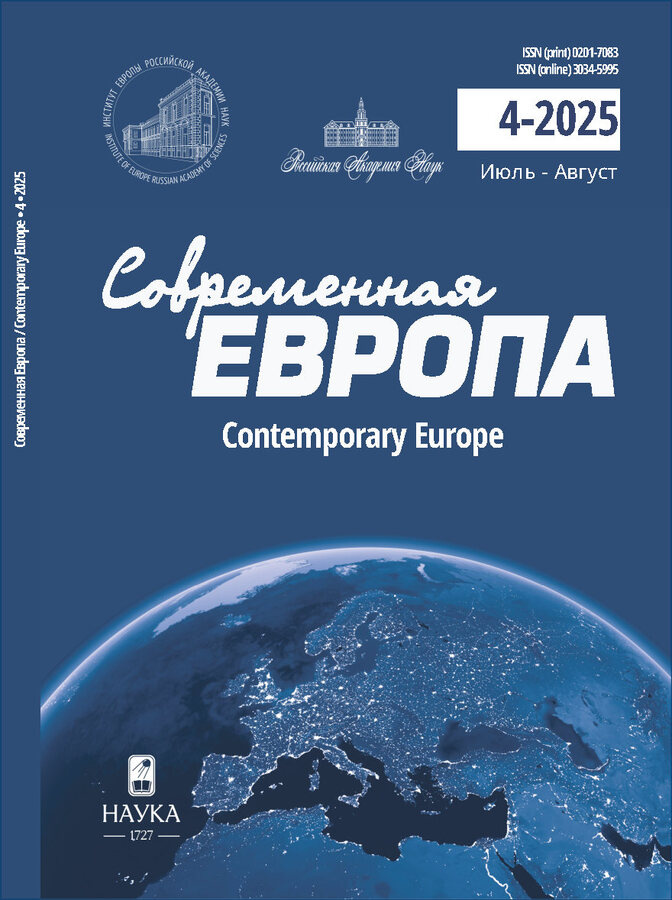The European Manufacturing: Development Tendencies
- Autores: Chetverikova A.S1
-
Afiliações:
- Primakov National Research Institute of World Economy and International Relations Russian Academy of Sciences (IMEMO)
- Edição: Nº 4 (132) (2025)
- Páginas: 147-161
- Seção: PROBLEMS OF ECONOMY
- URL: https://cardiosomatics.orscience.ru/0201-7083/article/view/691014
- DOI: https://doi.org/10.31857/S0201708325040138
- ID: 691014
Citar
Texto integral
Resumo
The article is devoted to the assessment of the dynamics of the European industry with the special attention to the manufacturing sector as one of the economic development factors. It has demonstrated that not all pan-European objectives are implemented and correspond to emerging challenges despite the EU long-standing strategic goals. Main tendencies and imbalances of the EU manufacturing are analysed primarily based on statistical analysis tools and “case study”. The dynamics of the factors influencing the sector competitiveness indicates its difficult position and partial lack of competitiveness in relation to the USA. Problems of decreasing labour productivity growth rate and negative effects of the energy factor remain. The EU is still characterised by the significant gap with the USA by the level of labour productivity as well as by energy cost for industrial consumers, that actualises the problem of industry relocation outwards the integration union. Territorial transformations take place: along with the general decrease of the sector share in the EU economy and its key states, the opposite tendencies new industrial centers are observed. The foreign capital impact on the European manufacturing and its special importance for individual states is demonstrated.
Palavras-chave
Sobre autores
A. Chetverikova
Primakov National Research Institute of World Economy and International Relations Russian Academy of Sciences (IMEMO)
Email: chetverikova@imemo.ru
Candidate of Science (Economics), Head of Center for European Studies Moscow, Russia
Bibliografia
- Бажан А.И. (2024) Инфляция в ЕС: форма, причины и антиинфляционная политика. Современная Европа. № 7. С. 100–110. doi: 10.31857/S0201708324070088
- Белов В.Б. (2023) Цифровая трансформация Европейского союза: через тернии к успехам? Научные труды Вольного экономического общества России. Т. 241. № 3. С. 213–226. doi: 10.38197/2072-2060-2023-241-3-213-226
- Буторина О.В. (2024) Доклад Драги прерывает «обед молчания» ЕС. Аналитические записки Института Европы РАН. № 3(39). С. 43–51. doi: 10.15211/analytics32120244351
- Варнавский В.Г. (2019) Глобализация и структурные сдвиги в мировом производстве. Мировая экономика и международные отношения. Т. 63. № 1. С. 25–33. doi: 10.20542/0131-2227-2019-63-1-25-33
- Говорова Н.В. (2019) Промышленная политика в ЕС. Научно-аналитический вестник ИЕ РАН. № 1. С. 108–113. doi: 10.15211/vestnikieran12019108113
- Кондратьев В.Б. (ред.) (2023) Промышленная политика в условиях трансформации глобальных стоимостных цепочек. ИМЭМО РАН, Москва. 190 с. doi: 10.20542/978-5-9535-0618-2
- Кондратьев В.Б. (2016) Возвращение производства, или новая индустриализация. Перспективы. Электронный журнал. № 4(8). С. 99–116.
- Кондратьев В.Б. (2015) Мировая обрабатывающая промышленность: сдвиги в конкурентных издержках. Мировая экономика и международные отношения. № 7. С. 5–15. doi: 10.20542/0131-2227-2015-7-5-15
- Кондратьева Н.Б. (2021) Единый внутренний рынок ЕС и европейская промышленность: обновление стратегии. Европейский союз: факты и комментарии. № 104. С. 15–19. doi: 10.15211/euftacts2202115
- Лобанов М.М., Звезданович-Лобанова Е., Звезданович М. (2022) Типологизация промышленных систем стран Центрально-Восточной и Юго-Восточной Европы. Журнал Новой экономической ассоциации. № 4 (56). С. 92–122. doi: 10.31737/2221-2264-2022-56-4-5
- Рогинко С.А. (2023) Денидустриализация Европы: иллюзия или реальность. Научные труды ВЭО России. Т. 241. № 3. С. 227–238. doi: 10.38197/2072-2060-2023-241-3-227-238
- Циренщиков В.С. (2020) Очередная версия промышленной политики ЕС. Современная Европа. № 6. С. 153–162. doi: 10.15211/soveurope62020153162
- Kandzija V., Tomljanovic M., Hudek I. (2017) Deindustrialization as a Process in the EU. Ekonomski vjesnik/Econviews. Vol. 30. No. 2. P. 399–414.
- Stentoft J., Mikkelsen O.S., Jensen J.K. (2016) Flexicurity and relocation of manufacturing. Oper Manag Res. No. 9. P. 133–144. doi: 10.1007/s12063-016-0110-3
- Zavarska Z., Bykova A., Grieveson R., Hanzl-Weiss D., Sankot O. (2023) Industrial Policy for a New Growth Model: a Toolbox for EU-CEE Countries, WIIW, Wien, Austria. 145 p.
Arquivos suplementares










